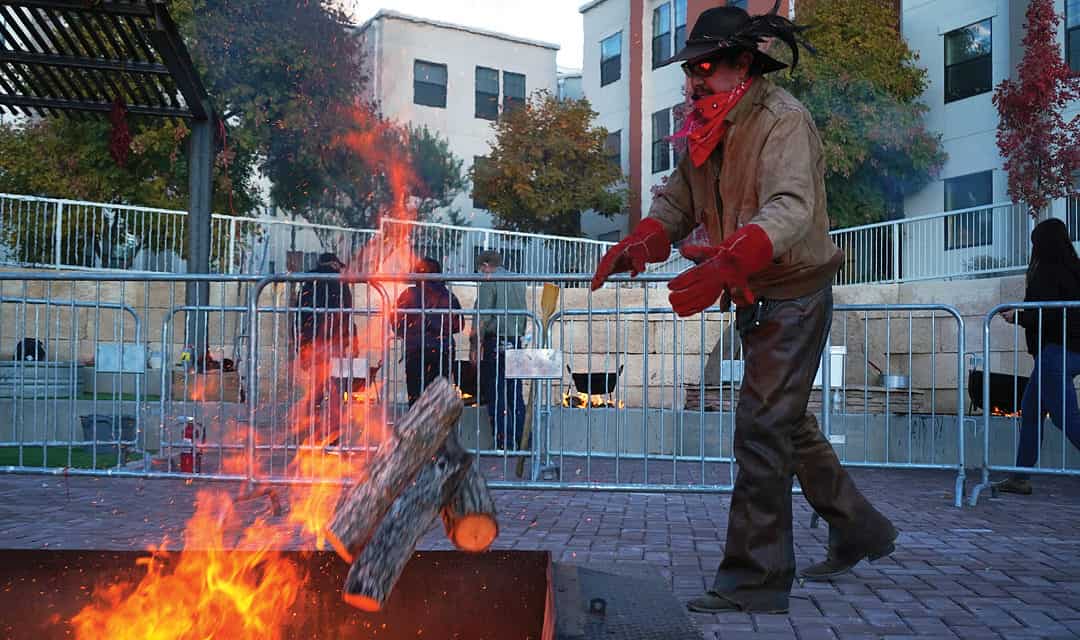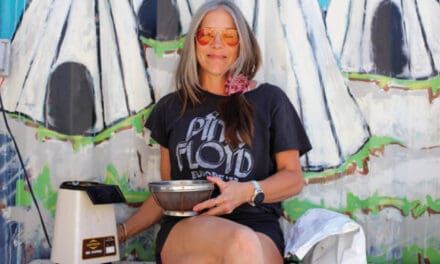Honoring the Legacy of Fabiola Cabeza de Baca
By Emily Withnall · Photos by Leon Bustos

Inside the horno constructed by the Torres family at the Cultural Park in Las Vegas.
The morning of the Matanza, it took seven people to lift the metal lid from the pit at the Cultural Park at New Mexico Highlands University (NMHU). A cloud of steam and the aroma of pork enveloped everyone, taking the edge off the chilly October morning. Eric Romero, chair of the Department of Languages and Culture at NMHU and the pit supervisor, was nervous about whether the meat would be properly done, since the Matanza marked the first time the Cultural Park and new pit were being used. An older pit, dug adjacent to the football field in the early 2000s, used adobe bricks as its lining, but this pit uses firebricks. To meet safety and health codes, the meat had to be at least 145 degrees. To Romero’s relief, the meat was 180 degrees and moist.
La matanza, which translates as “the killing,” originated in Spain during a period of Moorish rule. Traditionally, it was practiced to distribute food to the community before winter. When the matanza was brought to the Americas, the tradition merged with Indigenous harvest practices that served a similar purpose for tribal communities.
For Romero, it’s important to recognize the matanza as a living and evolving celebration. “It’s not just recognizing Indigenous heritage and ancestors but recognizing that their teaching and their contributions are still here—and it’s best evidenced by food traditions,” he explains. “Cuisine is not following a recipe; it’s about inserting yourself within a tradition of culture in a discourse of food.”
With the construction of the Cultural Park, the brainchild of the university’s Diversity, Equity and Inclusion Advisory Council, Romero hopes to expand the discourse of cultural food traditions across campus, throughout Las Vegas, and among the small communities nearby. For Romero, the Cultural Park is also a way to honor the legacy of NMHU alumna Fabiola Cabeza de Baca.
Cabeza de Baca was one of the first to publish a recipe for the hard-shell taco and propagated the widespread use of chopped green chile as relish on New Mexican dishes. And as her books and other publications reveal, Cabeza de Baca was deeply dedicated to the cultivation and preservation of traditional New Mexican recipes.
“In the matter of how we’re working with the Cultural Park, we want to reiterate some of those traditions and share them with students, so they develop their own story, narrative, cuisine, and creations,” says Romero.
The Cultural Park is an open space adjacent to the university’s newest dorm buildings. The ground is brick lined, and banco seating stretches the length of the back side of the cooking area, surrounded by a low wall. Near the pit, an horno constructed by the Torres family from Questa sits on a concrete platform. Known for their horno building, the Torres father, son, and daughter worked together on this project, which includes chains dangling from the dome inside for hanging meat, a thermometer embedded in the wall, and a traditional enjarre coating.
According to Romero, many Pueblos will not use a new horno until it has been blessed, so he asked Hummingbird Calabaza of the Tewa nation to perform the blessing. “Our first cook was traditional, of course,” he exclaims with a laugh. “Pizza!”
For the Matanza, the horno was used to roast sweet corn as well as maiz del concho (white dent corn) to make chicos. A cylinder roaster was brought in for chile. Romero says the corn all came from the Pecos Valley. “Our preference, of course, is to buy locally.”
Romero sees the Cultural Park as a way to rebuild the kind of food sovereignty that Cabeza de Baca supported throughout her life. “Historically, Las Vegas and northern New Mexico have had an agricultural foundation,” he says. “But right now, we’re a food desert. We don’t eat the food we produce.”
Romero attributes both the beginning of the decline of agriculture in the state and Indigenous land loss to the railroad, which arrived in New Mexico in 1879. He says New Mexico’s Office of the Surveyor General colluded with private landowners to take Indigenous land and forced people into cities. And although many agricultural practices have continued in New Mexico, these practices have shifted away from vegetable farming and toward ranching.
Cabeza de Baca was born in La Liendre to a landowning Hispano family in the late 1800s, just as the railroad and shift toward ranching became prominent in New Mexico. She earned her home economics certificate from New Mexico Normal School, which later became NMHU. Cabeza de Baca then worked as a Spanish teacher while she earned her degree in home economics at New Mexico State University. Her expertise in Spanish, education, and home economics caught the attention of New Mexico’s director of the Agricultural Extension Service, a program initiated across the United States in 1914 to support farmers with research and information, introduce new technology, and encourage them to stay on the land.

The Cultural Park at New Mexico Highlands University includes a cooking area with an horno and a matanza fire pit.
Rural, Spanish-speaking New Mexico, however, was slow in adapting the government’s initiatives. It wasn’t until 1917 that the state’s Extension Service hired Spanish-speaking agents, and when Cabeza de Baca joined in 1929, she was among just a few of the agency’s Spanish-speaking Hispano women.
Although Cabeza de Baca’s wealthy upbringing initially presented some barriers when she visited small villages, her natural curiosity ultimately made her successful. “She represented the government going into households and introducing new food traditions,” Romero says. “That was really an interesting period because you think it would be somewhat antagonistic to have government workers going into communities and telling locals how to cook their food.”
The blending of cultural traditions and acknowledgement of generational change made Cabeza de Baca more effective than other extension agents. As she wrote in the Journal of Home Economics in 1942, a family she visited once served her fried potatoes, canned beef, and white bread while they ate beans, chile, and tortillas. When she asked them why they had served her different food, they said “We thought you didn’t like the kind of food we poor people eat.” She explained that not only did she eat the same food, but that it was much more nutritious. Her now-101-year-old cousin, and former New Mexico legislator, J. Paul Taylor, remembers that she was always received warmly. “I went with her to some of those villages,” he says. “It was always so nice because she was so welcome there.”
Cabeza de Baca’s respect for food traditions outside her own, such as various Pueblo food traditions, and her willingness to incorporate those traditions into her work and recipes, are a model for students at NMHU, who are now engaged in a similar type of learning. A curved strip of land surrounding the Cultural Park’s cooking area will soon be filled with a heritage orchard and healing herb garden. Some native trees have already been transplanted, including chokecherry, sour cherry, gooseberry, and elderberry. Apple and plum trees will soon be added.
Romero says the herb garden will be planned by students. “Part of our work for the Diversity Council is the emphasis of place-based education. You look at where your students are coming from and their embedded knowledge that’s coming from the environment and community,” says Romero. “And for people coming from elsewhere, they learn the local tradition.”
Incorporating students’ cultural traditions, scientific knowledge, and community narratives into the learning process is fundamental to the idea behind the Cultural Park. As Romero points out, the physics of the matanza pit comes from cultural scientific knowledge. The night before the park’s inaugural Matanza, Romero and his crew prepared the pit by layering in twenty inches of hot oak embers, followed by sheet metal, a layer of sand, several fifty-pound roasts wrapped in burlap, another layer of sand, more sheet metal, and, finally, a fire covered by the heavy metal lid. Buried in layers of metal, sand, and fire, the pig is steamed for fourteen hours overnight in a process that has changed little since eighth-century Spain.
Romero says some families in New Mexico still practice matanzas by digging a hole in their backyard, and he has learned that many other cultures across the world practice similar customs. “We’ve had international students that came to the matanzas we used to do with the student group Movimiento Estudiantil Chicano de Aztlán, and we’d get invited to their version of a matanza,” he notes. “The Cameroonian students roast a sheep, and the Samoan and Polynesian students have their own form of this too.”
The healing herb garden and heritage orchard at the Cultural Park are a part of a bigger vision across campus and in Las Vegas. Faculty and staff have already started a pollinator garden and a community garden, and Romero is working with his acequia class to assess campus landscaping as an option for planting herbs and foods.
“We’re hoping the grounds crew considers using all bioavailable space on campus for planting food,” he says. “The beds outside Douglas Hall were used for flowers, but at one time a secretary was using it for a squash garden. I want us to really look at our campus as a museum space and a learning space.”
The vision for the Cultural Park and gardens extends beyond the NMHU campus and includes the broader public. The shaded bancos in the park make it an ideal setting for celebrations, lectures, and food-centric events. Romero hopes the park will soon include a permanent grill and smoker for event use. During the Matanza last fall, the community gathering spilled into Melody Park across the street, which easily accommodated the five hundred people in attendance. As people lined up to receive heaping plates of pork and beef roast, chicharrones, tamales, and corn, the local band Fireball played blues and rock songs. The sweet, earthy smell of roasting chile filled the air.
For Romero, the road to food sovereignty starts from the ground up. “It’s one of those cultural shifts that takes a long time,” he emphasizes. “Part of that bottom-up cultural change could be small farms, ranches, community gardens, and urban gardens. With a bunch of capillary-level projects, we hope to impact students so that they’re going back to their representative communities—and particularly those who are coming from rural communities in New Mexico—and looking at the issue.”
Romero jokes about our reliance on being able to buy kiwifruit from Walmart in January, but he says this as an example of the way economics and energy costs dictate our eating behaviors. For food sovereignty to take root, returning to traditional and regional food is essential. “Understand global, but buy local, and invest in your farmers market, invest in your school systems using local produce, and reconsider regulations that prohibit foraging.”
Like Cabeza de Baca, Romero once traveled to many rural areas as a part of a rural education grant he received. Traveling on dirt roads, he began mapping the food he came across and recording timelines for when asparagus or wild plums appeared in various parts of northern New Mexico. “One of the activities I’m working with this semester is an almanac system called las cabañuelas,” Romero says. “Las cabañuelas is environmental and planning forecasting. It’s a Spanish tradition brought to the Americas and incorporated into Indigenous knowledge systems.”
Although Romero describes las cabañuelas as folklore, he explains that it’s a useful tool to help students chronicle different planning cycles based on elevation, micro-environment, and climate change. And it can also be useful to pay attention to the animals. “I have some beautiful chokecherry trees I have to pick on just the right weekend because otherwise the starlings will eat them—you have to look for that signal,” Romero says. “Uno para mi, uno para vos, y uno para los pajaritos que son la palabra de dios.”

Left: Preparing meat for the Matanza. Right: Matanza pit.
Cabeza de Baca was also known for cultivating attention to the natural world and sharing its riches freely with others. The recipes she collected from the Native, Anglo, and Hispanic communities in northern New Mexico became so popular that she published them in her 1931 book, Historic Cookery. It was so popular that New Mexico governor Thomas Mabry sent a copy to every state governor across the country, along with a sack of pinto beans. The book was a testament to the living, changing nature of food and culture and was republished many times.
“She demonstrated flexibility and creativity rather than being a staunch defender of one singular traditional way of cooking,” says Romero. “She facilitated that creativity and created contemporary cuisine. She was ahead of her time.”
In her work, Cabeza de Baca was adept at connecting with people from many cultures and backgrounds, and she reportedly taught herself Tewa and Tiwa. Cabeza de Baca also understood that change was inevitable. Her preservation of Hispano history and multicultural recipes, and her unconventional life as an educated, divorced woman with no children, demonstrated to New Mexicans in that era (and ever since) that observing traditions and embracing change were not at odds.
In addition to her extension work, Cabeza de Baca wrote for numerous publications, and after she retired, she was a consultant for the United Nations and the Peace Corps. Her writing began with extension service circulars, but she had long been interested in collecting folklore, legends, and dichos. “To really become part of the community, you have to be familiar with the stories that precede you,” says Romero. “What better mechanism besides food stories? When I take a picture of my tacos and send them to you on the other side of the United States, I’m engaging in that tradition. Storytelling centered around food is historic.”
Romero sees the Cultural Park as an invitation to the whole community to move toward food sovereignty. “When you’re eating a nice, succulent chicharrón, perhaps that idea is going to stick with you.” Laughing, he adds, “Rather than aromatherapy, we’ll do chicharrón therapy.”
As a child, Romero was raised within the matanza tradition, which he sees as addressing sustainability issues and disparities within the community. “When we had food left over in my family, I was the corredor. I would take the leftover calabacitas to the vecinos, and particularly the elders in the community,” recalls Romero. “If they didn’t show up, there was still a consideration and concern to get them food.”
Food distribution was an integral part of the Cultural Park Matanza as well. Community members took home boxes filled with tamales, chicharrones, and roast. Those who prepared the pig the night prior to the Matanza helped distribute lard to those who wanted it. In keeping with the matanza tradition, every part of the animal was used.
Romero says the Highlands Diversity, Equity and Inclusion Advisory Council sees the Cultural Park as a step toward offering culturally responsive, place-based learning to the campus and beyond. “This is our opportunity to create systems of authentic education, which recognize local knowledge, local science, and local tradition not as enrichment but as the foundation for shifts within curriculum,” he reflects. “And there’s a community-building concern at the same time. This is how you build communities—you share bread.”

Emily Withnall
Emily Withnall was raised in Las Vegas, NM, and currently serves as the editorial assistant at New Mexico Highlands University. Her freelance work has appeared inEl Palacio Magazine,Al Jazeera,High Country News,Ms. Magazine,Gay Magazine,Tin House,Kenyon Review, and other publications, and can be read atemilywithnall.com.













